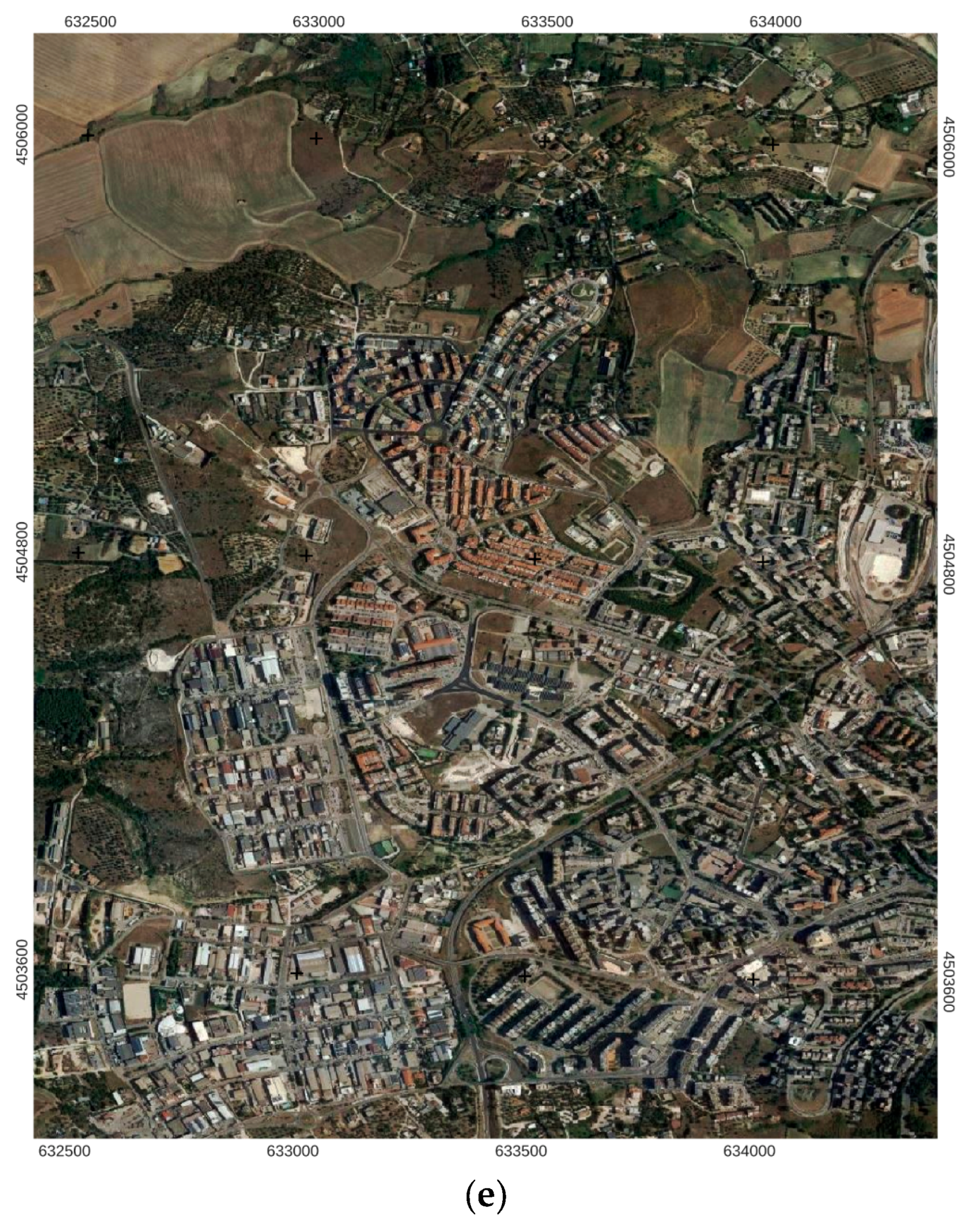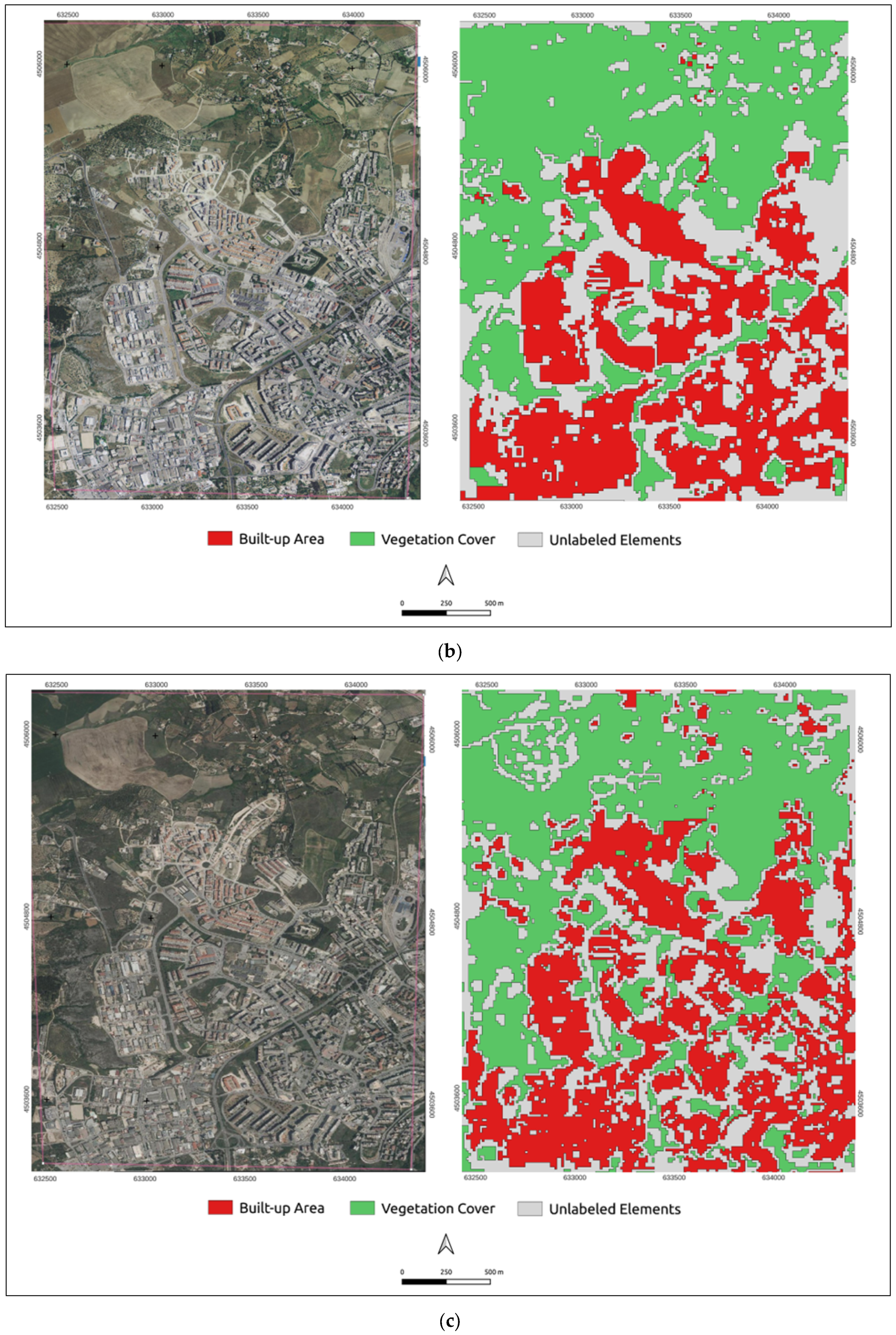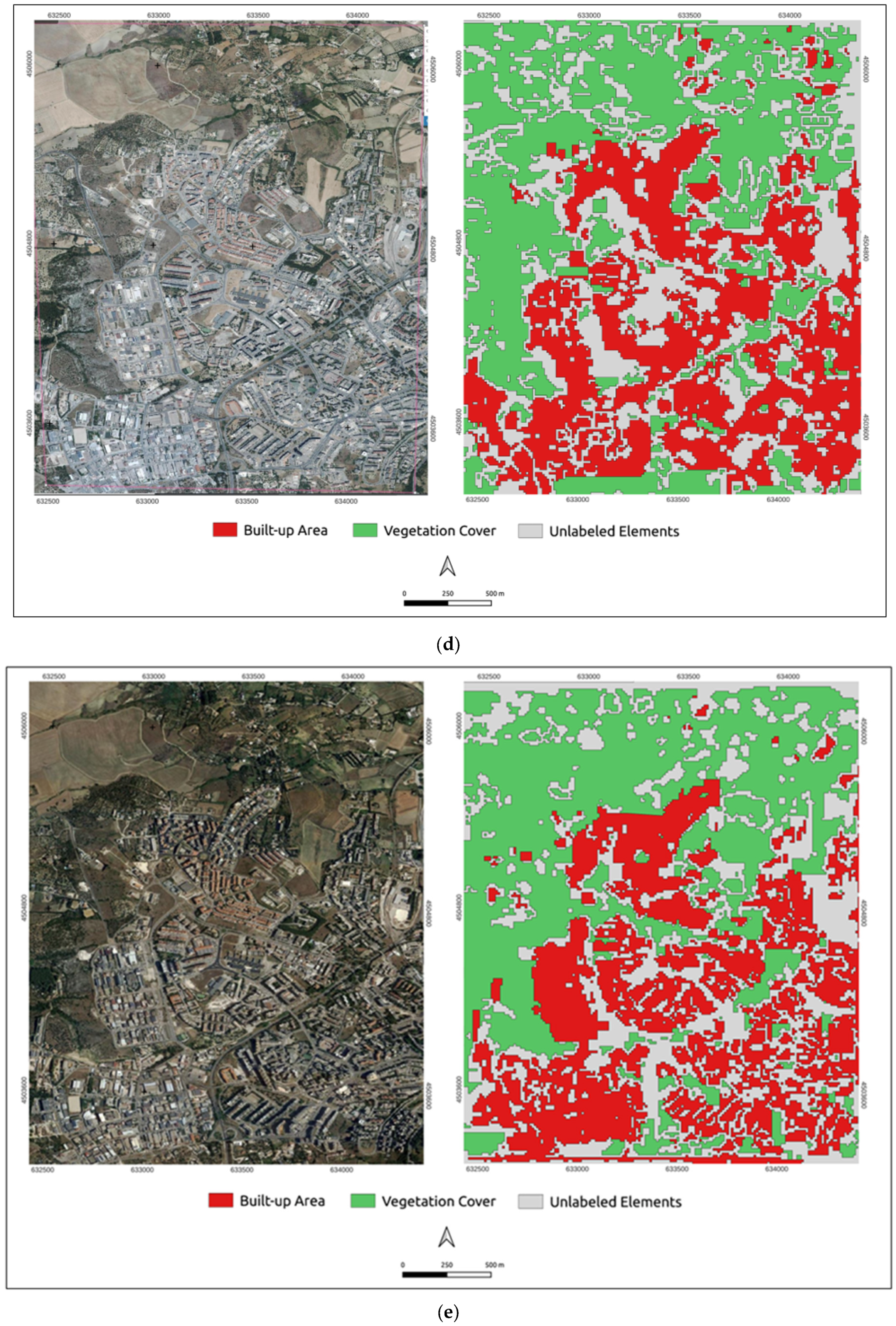Combining Deep Learning and Multi-Source GIS Methods to Analyze Urban and Greening Changes
Abstract
1. Introduction
2. Study Area and Dataset
2.1. Study Area
2.2. Remote Sensing Imagery Dataset
3. Methodology
3.1. Urban and Greening Classification and Segmentation
3.1.1. Training and Validation of the U-Net Model
3.1.2. Testing the Accuracy Assessment of the Model
3.2. Urban and Greening Changes Analysis
4. Results
4.1. Accuracy Assessment of the U-Net Model
4.2. Urban and Greening Changes Analysis Results
5. Discussion
6. Conclusions
Supplementary Materials
Author Contributions
Funding
Institutional Review Board Statement
Informed Consent Statement
Data Availability Statement
Conflicts of Interest
References
- UN (United Nations). The 2030 Agenda for Sustainable Development; United Nations: New York, NY, USA, 2015. [Google Scholar]
- Holden, E.; Norland, I. Three challenges for the compact city as a sustainable urban form: Household consumption of energy and transport in eight residential areas in the greater Oslo Region. Urban Stud. 2005, 42, 2145–2166. [Google Scholar] [CrossRef]
- Jenks, M.; Burgess, R. Compact Cities: Sustainable Urban Forms for Developing Countries; Spon Press: London, UK, 2000. [Google Scholar]
- Westerink, J.; Haase, D.; Bauer, A.; Ravetz, J.; Jarrige, F.; Aalbers, C. Expressions of the compact city paradigm in peri-urban planning across European city regions–how do planners deal with sustainability trade-offs. Eur. Plan. Stud. 2012, 25, 1–25. [Google Scholar] [CrossRef]
- Elmqvist, T.; Bai, X.; Frantzeskaki, N.; Griffith, C.; Maddox, D.; McPhearson, T.; Parnell, S.; Romero-Lankao, P.; Simon, D.; Watkins, M. The Urban Planet: Knowledge towards Sustainable Cities; Cambridge University Press: Cambridge, UK, 2018. [Google Scholar]
- Nuissl, H.; Haase, D.; Lanzendorf, M.; Wittmer, H. Environmental impact assessment of urban land use transitions—A context-sensitive approach. Land Use Policy 2009, 26, 414–424. [Google Scholar] [CrossRef]
- Wolff, M.; Haase, D. Mediating sustainability and liveability—Turning points of green space supply in European Cities. Front. Environ. Sci. 2019, 7, 61. [Google Scholar] [CrossRef]
- Ten Brink, P.; Mutafoglu, K.; Schweitzer, J.P.; Kettunen, M.; Twigger-Ross, C.; Baker, J.; Dekker, S. The Health and Social Benefits of Nature and Biodiversity Protection. A Report for the European Commission (ENV. B. 3/ETU/2014/0039); Institute for European Environmental Policy: London, UK; Brussels, Belgium, 2016. [Google Scholar]
- Kabisch, N. Ecosystem Service Implementation and Governance Challenges in Urban Green Space Planning: The Case of Berlin, Germany. Land Use Policy 2015, 42, 557–567. [Google Scholar] [CrossRef]
- Zhang, Y.; Van den Berg, A.E.; Van Dijk, T.; Weitkamp, G. Quality over Quantity: Contribution of urban green space to neighborhood satisfaction. Int. J. Environ. Res. Public Health 2017, 14, 535. [Google Scholar] [CrossRef]
- Fuller, R.A.; Gaston, K.J. The scaling of green space coverage in European cities. Biol. Lett. 2009, 5, 352–355. [Google Scholar] [CrossRef]
- Balikçi, S.; Giezen, M.; Arundel, R. The paradox of planning the compact and green city: Analyzing land-use change in Amsterdam and Brussels. J. Environ. Plan. Manag. 2022, 65, 2387–2411. [Google Scholar] [CrossRef]
- Wellmann, T.; Schug, F.; Haase, D.; Pflugmacher, D.; van der Linden, S. Green growth? On the relation between population density, land use and vegetation cover fractions in a city using a 30-years Landsat time series. Landsc. Urban Plan. 2020, 202, 103857. [Google Scholar] [CrossRef]
- Montero, E.; Wolvelaer, J.V.; Garzón, A. The European Urban Atlas. In Land Use and Land Cover Mapping in Europe. Remote Sensing and Digital Image Processing; Manakos, I., Braun, M., Eds.; Springer: Dordrecht, The Netherlands, 2014; Volume 18, pp. 115–124. [Google Scholar] [CrossRef]
- Skokanová, H.; González, I.L.; Slach, T. Mapping green infrastructure elements based on available data, a case study of the Czech Republic. J. Landsc. Ecol. 2020, 13, 85–103. [Google Scholar] [CrossRef]
- Mas, J.F.; Lemoine-Rodríguez, R.; González-López, R.; López-Sánchez, J.; Piña-Garduño, A.; Herrera-Flores, E. Land use/land cover change detection combining automatic processing and visual interpretation. Eur. J. Remote Sens. 2017, 50, 626–635. [Google Scholar] [CrossRef]
- Hashem, N.; Balakrishnan, P. Change analysis of land use/land cover and modelling urban growth in Greater Doha, Qatar. Ann. GIS 2015, 21, 233–247. [Google Scholar] [CrossRef]
- Liou, Y.A.; Nguyen, A.K.; Li, M.H. Assessing spatiotemporal eco-environmental vulnerability by Landsat data. Ecol. Indic. 2017, 80, 52–65. [Google Scholar] [CrossRef]
- Chen, Z.; Wang, L.; Wei, A.; Gao, J.; Lu, Y.; Zhou, J. Land-use change from arable lands to orchards reduced soil erosion and increased nutrient loss in a small catchment. Sci. Total Environ. 2019, 648, 1097–1104. [Google Scholar] [CrossRef]
- Maxwell, A.E.; Warner, T.A.; Fang, F. Implementation of machine-learning classification in remote sensing: An applied review. Int. J. Remote Sens. 2018, 39, 2784–2817. [Google Scholar] [CrossRef]
- Talukdar, S.; Singha, P.; Mahato, S.; Shahfahad; Pal, S.; Liou, Y.-A.; Rahman, A. Land-Use Land-Cover Classification by Machine Learning Classifiers for Satellite Observations—A Review. Remote Sens. 2020, 12, 1135. [Google Scholar] [CrossRef]
- Ur Rahman, H.; Ch, N.J.; Manzoor, S.; Najeeb, F.; Siddique, M.Y.; Khan, R.A. A comparative analysis of machine learning approaches for plant disease identification. Adv. Life Sci. 2017, 4, 120–126. [Google Scholar]
- Ma, L.; Liu, Y.; Zhang, X.; Ye, Y.; Yin, G.; Johnson, B.A. Deep learning in remote sensing applications: A meta-analysis and review. ISPRS J. Photogramm. Remote Sens. 2019, 152, 166–177. [Google Scholar] [CrossRef]
- Shih, H.C.; Stow, D.A.; Tsai, Y.H. Guidance on and comparison of machine learning classifiers for Landsat-based land cover and land use mapping. Int. J. Remote Sens. 2019, 40, 1248–1274. [Google Scholar] [CrossRef]
- Ma, L.; Li, M.; Ma, X.; Cheng, L.; Du, P.; Liu, Y. A review of supervised object-based land-cover image classification. ISPRS J. Photogramm. Remote Sens. 2017, 130, 277–293. [Google Scholar] [CrossRef]
- Carranza-García, M.; García-Gutiérrez, J.; Riquelme, J.C. A framework for evaluating land use and land cover classification using convolutional neural networks. Remote Sens. 2019, 11, 274. [Google Scholar] [CrossRef]
- Shayeganpour, S.; Tangestani, M.H.; Homayouni, S.; Vincent, R.K. Evaluating pixel-based vs. object-based image analysis approaches for lithological discrimination using VNIR data of WorldView-3. Front. Earth Sci. 2021, 15, 38–53. [Google Scholar] [CrossRef]
- Khosravi, I.; Momeni, M. Presenting an object-based approach using image edges to detect building boundaries from high spatial resolution images. Iran. J. Sci. Technol. Trans. Electr. Eng. 2018, 42, 95–105. [Google Scholar] [CrossRef]
- Qin, R.; Liu, T. A Review of Landcover Classification with Very-High Resolution Remotely Sensed Optical Images—Analysis Unit, Model Scalability and Transferability. Remote Sens. 2022, 14, 646. [Google Scholar] [CrossRef]
- Cowen, D.J.; Jensen, J.R.; Bresnahan, P.J.; Ehler, G.B.; Graves, D.; Huang, X. The design and implementation of an integrated geographic information system for environmental applications. Photogramm. Eng. Remote Sens. 1995, 61, 1393–1404. [Google Scholar]
- Haber, E.A.; Santos, M.J.; Leitão, P.J.; Schwieder, M.; Ketner, P.; Ernst, V.; Rietkerk, M.; Wassen, M.J.; Eppinga, M.B. High spatial resolution mapping identifies habitat characteristics of the invasive vine Antigonon leptopus on St. Eustatius (Lesser Antilles). Biotropica 2021, 53, 941–953. [Google Scholar] [CrossRef]
- Ennouri, K.; Smaoui, S.; Gharbi, Y.; Cheffi, M.; Ben Braiek, O.; Ennouri, M.; Triki, M.A. Usage of artificial intelligence and remote sensing as efficient devices to increase agricultural system yields. J. Food Qual. 2021, 2021, 6242288. [Google Scholar] [CrossRef]
- Imane, S.; Mohamed, R.; Mustapha, H. A comparison of GEOBIA Vs PBIA machine learning methods for lithological mapping using Sentinel 2 imagery: Case study of Skhour Rehamna, Morocco. In Proceedings of the 2020 IEEE International Conference of Moroccan Geomatics (MORGEO), Casablanca, Morocco, 11–13 May 2020. [Google Scholar]
- Ghorbanzadeh, O.; Blaschke, T.; Gholamnia, K.; Meena, S.R.; Tiede, D.; Aryal, J. Evaluation of Different Machine Learning Methods and Deep-Learning Convolutional Neural Networks for Landslide Detection. Remote Sens. 2019, 11, 196. [Google Scholar] [CrossRef]
- Nogueira, K.; Penatti, O.A.; Dos Santos, J.A. Towards better exploiting convolutional neural networks for remote sensing scene classification. Pattern Recognit. 2017, 61, 539–556. [Google Scholar] [CrossRef]
- Scott, G.J.; England, M.R.; Starms, W.A.; Marcum, R.A.; Davis, C.H. Training deep convolutional neural networks for land–cover classification of high-resolution imagery. IEEE Geosci. Remote Sens. Lett. 2017, 14, 549–553. [Google Scholar] [CrossRef]
- Shafaey, M.A.; Salem, M.A.M.; Ebied, H.M.; Al-Berry, M.N.; Tolba, M.F. Deep learning for satellite image classification. In Proceedings of the International Conference on Advanced Intelligent Systems and Informatics, Cairo, Egypt, 1–3 September 2018. [Google Scholar]
- Helber, P.; Bischke, B.; Dengel, A.; Borth, D. Eurosat: A novel dataset and deep learning benchmark for land use and land cover classification. IEEE J. Sel. Top. Appl. Earth Obs. Remote Sens. 2019, 12, 2217–2226. [Google Scholar] [CrossRef]
- Pires de Lima, R.; Marfurt, K. Convolutional neural network for remote-sensing scene classification: Transfer learning analysis. Remote Sens. 2019, 12, 86. [Google Scholar] [CrossRef]
- Ndikumana, E.; Ho Tong Minh, D.; Baghdadi, N.; Courault, D.; Hossard, L. Deep recurrent neural network for agricultural classification using multitemporal SAR Sentinel-1 for Camargue, France. Remote Sens. 2018, 10, 1217. [Google Scholar] [CrossRef]
- Yuksel, M.E.; Basturk, N.S.; Badem, H.; Caliskan, A.; Basturk, A. Classification of high resolution hyperspectral remote sensing data using deep neural networks. J. Intell. Fuzzy Syst. 2018, 34, 2273–2285. [Google Scholar] [CrossRef]
- Yu, J.; Zeng, P.; Yu, Y.; Yu, H.; Huang, L.; Zhou, D. A Combined Convolutional Neural Network for Urban Land-Use Classification with GIS Data. Remote Sens. 2022, 14, 1128. [Google Scholar] [CrossRef]
- Ronneberger, O.; Fischer, P.; Brox, T. U-net: Convolutional networks for biomedical image segmentation. In Proceedings of the Medical Image Computing and Computer-Assisted Intervention (MICCAI), Munich, Germany, 5–9 October 2015. [Google Scholar]
- Yi, Y.; Zhang, Z.; Zhang, W.; Zhang, C.; Li, W.; Zhao, T. Semantic Segmentation of Urban Buildings from VHR Remote Sensing Imagery Using a Deep Convolutional Neural Network. Remote Sens. 2019, 11, 1774. [Google Scholar] [CrossRef]
- Sherrah, J. Fully Convolutional Networks for Dense Semantic Labelling of High-Resolution Aerial Imagery. arXiv 2016, arXiv:1606.02585. [Google Scholar] [CrossRef]
- Badrinarayanan, V.; Kendall, A.; Cipolla, R.; Member, S. SegNet: A Deep Convolutional Encoder-Decoder Architecture for Image Segmentation. IEEE Trans. Pattern Anal. Mach. Intell. 2017, 39, 2481–2495. [Google Scholar] [CrossRef]
- Wilhelm, T.; Koßmann, D. Land Cover Classification from a Mapping Perspective: Pixelwise Supervision in the Deep Learning Era. In Proceedings of the 2021 IEEE International Geoscience and Remote Sensing Symposium (IGARSS), Brussels, Belgium, 11–16 July 2021. [Google Scholar]
- Schmitt, M.; Hughes, L.H.; Qiu, C.; Zhu, X.X. SEN12MS—A Curated Dataset of Georeferenced Multi-Spectral Sentinel-1/2 Imagery for Deep Learning and Data Fusion. arXiv 2019, arXiv:1906.07789. [Google Scholar] [CrossRef]
- Sumbul, G.; Charfuelan, M.; Demir, B.; Markl, V. Bigearthnet: A Large-Scale Benchmark Archive for Remote Sensing Image Understanding. In Proceedings of the IEEE International Geoscience and Remote Sensing Symposium (IGARSS), Yokohama, Japan, 28 July–2 August 2019. [Google Scholar]
- Mohan, S.; Giridhar, M.V.S.S. A Brief Review of Recent Developments in the Integration of Deep Learning with GIS. Geomat. Environ. Eng. 2022, 16, 21–38. [Google Scholar] [CrossRef]
- Ma, J.; Cheng, J.C.P. Estimation of the building energy use intensity in the urban scale by integrating GIS and big data technology. Appl. Energy 2016, 183, 182–192. [Google Scholar] [CrossRef]
- Li, W.; He, C.; Fang, J.; Zheng, J.; Fu, H.; Yu, L. Semantic Segmentation-Based Building Footprint Extraction Using Very High-Resolution Satellite Images and Multi-Source GIS Data. Remote Sens. 2019, 11, 403. [Google Scholar] [CrossRef]
- Kucklick, J.P.; Müller, J.; Beverungen, D.; Mueller, O. Quantifying the impact of location data for real estate appraisal—A GIS-based deep learning approach. In Proceedings of the European Conference on Information Systems (EICS), Marrakech, Marocco, 14–16 June 2021. [Google Scholar]
- Zhang, Y.; Li, S.; Dong, R.; Deng, H.; Fu, X.; Wang, C.; Yu, T.; Jia, T.; Zhao, J. Quantifying physical and psychological perceptions of urban scenes using deep learning. Land Use Policy 2021, 111, 105762. [Google Scholar] [CrossRef]
- Francini, M.; Salvo, C.; Viscomi, A.; Vitale, A. A Deep Learning-Based Method for the Semi-Automatic Identification of Built-Up Areas within Risk Zones Using Aerial Imagery and Multi-Source GIS Data: An Application for Landslide Risk. Remote Sens. 2022, 14, 4279. [Google Scholar] [CrossRef]
- Population Trend Matera 2001–2021. Available online: https://www.tuttitalia.it/basilicata/73-matera/statistiche/popolazione-andamento-demografico/ (accessed on 26 January 2023).
- Munafò, M. Consumo di Suolo, Dinamiche Territoriali e Servizi Ecosistemici. Edizione 2022; Report SNPA 32/22; Italian National System for Environmental Protection: Rome, Italy, 2022.
- Yang, S.; Xiao, W.; Zhang, M.; Guo, S.; Zhao, J.; Shen, F. Image Data Augmentation for Deep Learning: A Survey. In Proceedings of the Computer Vision and Pattern Recognition Conference (CVPR), New Orleans, LA, USA, 19–24 June 2022. [Google Scholar]
- Minaee, S.; Boykov, Y.; Porikli, F.; Plaza, A.; Kehtarnavaz, N.; Terzopoulos, D. Image Segmentation Using Deep Learning: A Survey. IEEE Trans. Pattern Anal. Mach. Intell. 2022, 44, 3523–3542. [Google Scholar] [CrossRef]
- Geoportale della Regione Basilicata. Available online: https://rsdi.regione.basilicata.it/ (accessed on 27 January 2023).
- Database di Sintesi Nazionale. Available online: https://www.igmi.org/it/dbsn-database-di-sintesi-nazionale (accessed on 27 January 2023).
- QGIS. 2022 QGIS User Guide. Available online: https://docs.qgis.org/3.22/it/docs/user_manual/ (accessed on 27 January 2023).
- Boughorbel, S.; Jarray, F.; El-Anbari, M. Optimal classifier for imbalanced data using Matthews correlation coefficient metric. PLoS ONE 2017, 12, e0177678. [Google Scholar] [CrossRef]
- Chinchor, N.; Sundheim, B.M. MUC-5 evaluation metrics. In Proceedings of the Fifth Message Understanding Conference (MUC-5), Baltimore, MD, USA, 25–27 August 1993. [Google Scholar]
- Spasov, A.; Petrova-Antonova, D. Transferability assessment of open-source deep learning model for building detection on satellite data. In Proceedings of the 16th GeoInfo Conference, New York, NY, USA, 11–14 October 2021. [Google Scholar]
- Burton, E. Measuring Urban Compactness in UK Towns and Cities. Environ. Plan. B Plan. Des. 2002, 29, 219–250. [Google Scholar] [CrossRef]
- Abdullahi, S.; Pradhan, B.; Jebur, M.N. GIS-Based Sustainable City Compactness Assessment Using Integration of MCDM, Bayes Theorem and RADAR Technology. Geocarto Int. 2015, 30, 365–387. [Google Scholar] [CrossRef]
- Abdullah, A.Y.M.; Law, J.; Butt, Z.A.; Perlman, C.M. Understanding the differential impact of vegetation measures on modeling the association between vegetation and psychotic and non-psychotic disorders in Toronto, Canada. Int. J. Environ. Res. Public Health 2021, 18, 4713. [Google Scholar] [CrossRef]
- Haaland, C.; van den Bosch, C.K. Challenges and strategies for urban greenspace planning in cities undergoing densification: A review. Urban For. Urban Green. 2015, 14, 760–771. [Google Scholar] [CrossRef]
- Kabisch, N.; Strohbach, M.; Haase, D.; Kronenberg, J. Urban green space availability in European cities. Ecol. Indic. 2016, 70, 586–596. [Google Scholar] [CrossRef]
- Tian, Y.; Jim, C.Y.; Wang, H. Assessing the landscape and ecological quality of urban green spaces in a compact city. Landsc. Urban Plan. 2014, 121, 97–108. [Google Scholar] [CrossRef]








| Indicator | Variable |
|---|---|
| Built-Up Area Density | Area of Built-Up to Reference Area |
| Vegetation Cover Density | Area of Vegetation Cover to Reference Area |
| Labels | F1-Score |
|---|---|
| Built-Up Area | 0.95 |
| Vegetation Cover | 0.97 |
| Labels | 2000 | 2006 | 2011 | 2017 | 2020 | |||||
|---|---|---|---|---|---|---|---|---|---|---|
| Coverage (ha) | Density (%) | Coverage (ha) | Density (%) | Coverage (ha) | Density (%) | Coverage (ha) | Density (%) | Coverage (ha) | Density (%) | |
| Built-up Area | 147.44 | 22.38 | 186.56 | 28.31 | 194.45 | 29.51 | 202.02 | 30.66 | 202.03 | 30.66 |
| Vegetation Cover | 272.31 | 41.33 | 253.64 | 38.49 | 246.82 | 37.46 | 238.93 | 36.26 | 238.49 | 36.19 |
| Unlabeled Elements | 239.16 | 36.30 | 218.71 | 33.19 | 217.64 | 33.03 | 217.96 | 33.08 | 218.40 | 33.15 |
| Total | 658.91 | 100 | 658.91 | 100 | 658.91 | 100 | 658.91 | 100 | 658.91 | 100 |
| Labels | 2000–2006 | 2006–2011 | 2011–2017 | 2017–2020 | |||||
|---|---|---|---|---|---|---|---|---|---|
| Coverage (ha) | Density (%) | Coverage (ha) | Density (%) | Coverage (ha) | Density (%) | Coverage (ha) | Density (%) | ||
| Built-up Area | 39.12 | 5.94 | 7.89 | 1.20 | 7.56 | 1.15 | 0.01 | 0.00 | |
| Vegetation Cover | −18.67 | −2.83 | −6.82 | −1.04 | −7.89 | −1.20 | −0.44 | −0.07 | |
| Unlabeled Elements | −20.45 | −3.10 | −1.07 | −0.16 | 0.32 | 0.05 | 0.43 | 0.07 | |
Disclaimer/Publisher’s Note: The statements, opinions and data contained in all publications are solely those of the individual author(s) and contributor(s) and not of MDPI and/or the editor(s). MDPI and/or the editor(s) disclaim responsibility for any injury to people or property resulting from any ideas, methods, instructions or products referred to in the content. |
© 2023 by the authors. Licensee MDPI, Basel, Switzerland. This article is an open access article distributed under the terms and conditions of the Creative Commons Attribution (CC BY) license (https://creativecommons.org/licenses/by/4.0/).
Share and Cite
Francini, M.; Salvo, C.; Vitale, A. Combining Deep Learning and Multi-Source GIS Methods to Analyze Urban and Greening Changes. Sensors 2023, 23, 3805. https://doi.org/10.3390/s23083805
Francini M, Salvo C, Vitale A. Combining Deep Learning and Multi-Source GIS Methods to Analyze Urban and Greening Changes. Sensors. 2023; 23(8):3805. https://doi.org/10.3390/s23083805
Chicago/Turabian StyleFrancini, Mauro, Carolina Salvo, and Alessandro Vitale. 2023. "Combining Deep Learning and Multi-Source GIS Methods to Analyze Urban and Greening Changes" Sensors 23, no. 8: 3805. https://doi.org/10.3390/s23083805
APA StyleFrancini, M., Salvo, C., & Vitale, A. (2023). Combining Deep Learning and Multi-Source GIS Methods to Analyze Urban and Greening Changes. Sensors, 23(8), 3805. https://doi.org/10.3390/s23083805








